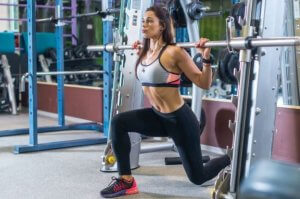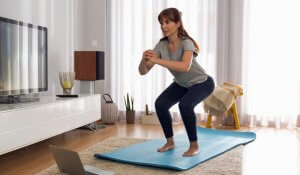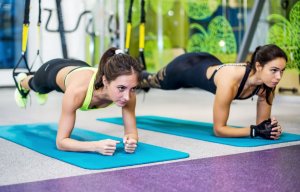Workout Regimen for Women: a Three-Day-a-Week Plan

A workout regimen that keeps you active three days a week is perfect for letting your muscles rest and recover. In addition, it gives you the freedom to enjoy other activities on your days off. In this article, we’ll give you examples of the exercises that can make up your weekly workout regimen.
Three-day-a-week workout regimen: option one
Let’s say you go to the gym (or work out at home) on Monday, Wednesday, and Friday, or Tuesday, Thursday, and Saturday. This will give you a day of rest in the middle of the regimen, which is highly beneficial for your muscles. In addition, you’ll also have the advantage of having free time for other obligations and activities. So pay attention to this three-day-a-week workout regimen for women:
Day one: chest, shoulders, and triceps
The first day of training focuses on the upper front body. The exercises: bench press with dumbbells, inclined openers, pec decks, presses with dumbbells, French presses (three sets of 12 repetitions each), lateral lifts, and rack lifts and pulls (two sets of 12 repetitions each).
Day two: legs and glutes
On the second day, you’ll focus on your lower body, something women usually pay more attention to. The exercises are as follows: sumo squats (four sets of 15 repetitions each), Romanian deadlifts (four sets of three repetitions each), calf lifts (three sets of 20 repetitions each), quad extensions (three sets of 15 repetitions each), and lunges (three sets of 12 repetitions each).

Day three: back and biceps
We’re back to the upper body, but this time the back area. The day’s exercises are: v-grip pulls, seated rows with rack, dumbbell rows, biceps curl with bar, and an alternate seated biceps curl (three sets of 12 repetitions each).
Every day you need to do 10 minutes of aerobic warmup, which can take the form of riding a stationary bike, a treadmill, or a stair climber. Also, include abdominal exercises. Do four sets of 20 repetitions each of the following: crunches, inverted crunches, and back crunches.
When you’re done with the routine, complement it with 30 minutes of cardio. Don’t forget to stretch at the end.
Three-day-a-week workout regimen: option two
So that you don’t become bored after a month of the regimen explained above, we recommend changing some of the exercises, their order, or the number of repetitions. This is another highly efficient regimen:
Day one: glutes, calves, and thighs
In order to work out the lower body, you’ll have to do the following exercises: wide lunges, Romanian deadlifts (four sets of 15 repetitions each), inclined leg curls, seated leg curls, hip lifts with bar, hip extensions with bar, calf raises (three sets of 15 repetitions each), and heel lifts without weights (two sets of 25 repetitions each).
Day two: full torso
On the second day, you’ll focus on the chest, the back, the shoulders, and the arms. The exercises are: closed pulls, military presses (four sets of 15 repetitions), open pulls, lifts, biceps curls, biceps extensions (three sets of 15 repetitions each), inclined presses, and seated rows (two sets of 15 repetitions).
Day three: adductors, abductors, and quads
Once again, we’re concentrating on the lower body. On the third day, you’ll do the following exercises: squats with bar (feet together), inclined presses, horizontal presses (four sets of 15 repetitions each). Continue the routine with adductor exercises (with a machine), abductor exercises (with a machine; three sets of 15 repetitions each), lumbar extensions (two sets of 20 repetitions each), and abdominal planks (three repetitions; 40 seconds on each).

As with the previous routine, it’s important to start with a 10-minute warmup, abdominal exercises, and 30 minutes of cardio. Also, remember to stretch all of your muscles, paying special attention to those you’ll be working out.
Getting good results with these routines is simply a matter of consistency and commitment. And of course, the guidance of a trainer and nutritionist. This way, you’ll see progress and reduce the risk of injuries and pains.
A workout regimen that keeps you active three days a week is perfect for letting your muscles rest and recover. In addition, it gives you the freedom to enjoy other activities on your days off. In this article, we’ll give you examples of the exercises that can make up your weekly workout regimen.
Three-day-a-week workout regimen: option one
Let’s say you go to the gym (or work out at home) on Monday, Wednesday, and Friday, or Tuesday, Thursday, and Saturday. This will give you a day of rest in the middle of the regimen, which is highly beneficial for your muscles. In addition, you’ll also have the advantage of having free time for other obligations and activities. So pay attention to this three-day-a-week workout regimen for women:
Day one: chest, shoulders, and triceps
The first day of training focuses on the upper front body. The exercises: bench press with dumbbells, inclined openers, pec decks, presses with dumbbells, French presses (three sets of 12 repetitions each), lateral lifts, and rack lifts and pulls (two sets of 12 repetitions each).
Day two: legs and glutes
On the second day, you’ll focus on your lower body, something women usually pay more attention to. The exercises are as follows: sumo squats (four sets of 15 repetitions each), Romanian deadlifts (four sets of three repetitions each), calf lifts (three sets of 20 repetitions each), quad extensions (three sets of 15 repetitions each), and lunges (three sets of 12 repetitions each).

Day three: back and biceps
We’re back to the upper body, but this time the back area. The day’s exercises are: v-grip pulls, seated rows with rack, dumbbell rows, biceps curl with bar, and an alternate seated biceps curl (three sets of 12 repetitions each).
Every day you need to do 10 minutes of aerobic warmup, which can take the form of riding a stationary bike, a treadmill, or a stair climber. Also, include abdominal exercises. Do four sets of 20 repetitions each of the following: crunches, inverted crunches, and back crunches.
When you’re done with the routine, complement it with 30 minutes of cardio. Don’t forget to stretch at the end.
Three-day-a-week workout regimen: option two
So that you don’t become bored after a month of the regimen explained above, we recommend changing some of the exercises, their order, or the number of repetitions. This is another highly efficient regimen:
Day one: glutes, calves, and thighs
In order to work out the lower body, you’ll have to do the following exercises: wide lunges, Romanian deadlifts (four sets of 15 repetitions each), inclined leg curls, seated leg curls, hip lifts with bar, hip extensions with bar, calf raises (three sets of 15 repetitions each), and heel lifts without weights (two sets of 25 repetitions each).
Day two: full torso
On the second day, you’ll focus on the chest, the back, the shoulders, and the arms. The exercises are: closed pulls, military presses (four sets of 15 repetitions), open pulls, lifts, biceps curls, biceps extensions (three sets of 15 repetitions each), inclined presses, and seated rows (two sets of 15 repetitions).
Day three: adductors, abductors, and quads
Once again, we’re concentrating on the lower body. On the third day, you’ll do the following exercises: squats with bar (feet together), inclined presses, horizontal presses (four sets of 15 repetitions each). Continue the routine with adductor exercises (with a machine), abductor exercises (with a machine; three sets of 15 repetitions each), lumbar extensions (two sets of 20 repetitions each), and abdominal planks (three repetitions; 40 seconds on each).

As with the previous routine, it’s important to start with a 10-minute warmup, abdominal exercises, and 30 minutes of cardio. Also, remember to stretch all of your muscles, paying special attention to those you’ll be working out.
Getting good results with these routines is simply a matter of consistency and commitment. And of course, the guidance of a trainer and nutritionist. This way, you’ll see progress and reduce the risk of injuries and pains.
This text is provided for informational purposes only and does not replace consultation with a professional. If in doubt, consult your specialist.








